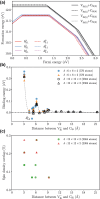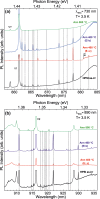Exhaustive characterization of modified Si vacancies in 4H-SiC
- PMID: 39635514
- PMCID: PMC11614345
- DOI: 10.1515/nanoph-2022-0400
Exhaustive characterization of modified Si vacancies in 4H-SiC
Abstract
The negatively charged silicon vacancy in silicon carbide is a well-studied point defect for quantum applications. At the same time, a closer inspection of ensemble photoluminescence and electron paramagnetic resonance measurements reveals an abundance of related but so far unidentified signals. In this study, we search for defects in 4H-SiC that explain the above magneto-optical signals in a defect database generated by automatic defect analysis and qualification (ADAQ) workflows. This search reveals only one class of atomic structures that exhibit silicon-vacancy-like properties in the data: a carbon antisite (CSi) within sub-nanometer distances from the silicon vacancy only slightly alters the latter without affecting the charge or spin state. Such a perturbation is energetically bound. We consider the formation of up to 2 nm distance and report their zero phonon lines and zero field splitting values. In addition, we perform high-resolution photoluminescence experiments in the silicon vacancy region and find an abundance of lines. Comparing our computational and experimental results, several configurations show great agreement. Our work demonstrates the effectiveness of a database with high-throughput results in the search for defects in quantum applications.
Keywords: SiC; high-throughput; photoluminescence; point defects; silicon vacancy.
© 2022 the author(s), published by De Gruyter, Berlin/Boston.
Figures






References
-
- Torpo L., Nieminen R. M., Laasonen K. E., Pöykkö S. Silicon vacancy in SiC: a high-spin state defect. Appl. Phys. Lett. 1999;74:221. doi: 10.1063/1.123299. - DOI
-
- Baranov P. G., Bundakova A. P., Soltamova A. A., et al. Silicon vacancy in SiC as a promising quantum system for single-defect and single-photon spectroscopy. Phys. Rev. B. 2011;83:125203. doi: 10.1103/physrevb.83.125203. - DOI
-
- Soykal O. O., Reinecke T. L. Quantum metrology with a single spin- 32 defect in silicon carbide. Phys. Rev. B. 2017;95:081405. doi: 10.1103/physrevb.95.081405. - DOI
LinkOut - more resources
Full Text Sources
